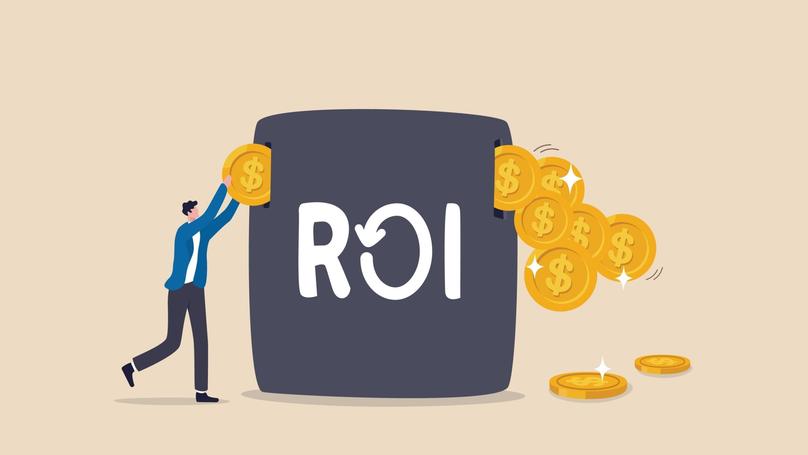ROI

What is ROI
ROI stands for Return On Investment. It's a financial indicator that shows a business's profitability (or lack thereof) by considering the funds invested in it. Simply put, ROI is a metric that helps determine the efficiency and return on investment, whether for the company itself, its marketing efforts, or the advertising of a specific product.
ROI is usually expressed as a percentage. Interestingly, each business sector has its ideal ROI value, meaning no universal "average" ROI figure exists. The positive coefficient is often considered a single average ROI indicator - the value that should be - practically none. This coefficient is believed to be equal to 100% or 0% (depending on the calculation formulas), indicating whether or not the investment is profitable.
ROI, ROMI, and ROAS
While we have already covered ROI, other related metrics include ROMI (Return On Marketing Investment) and ROAS (Return On Ad Spend).
ROMI calculates the return on investment, specifically in a company's marketing efforts. This indicator measures the effectiveness of marketing activities across various channels-digital and offline advertising, promotions, exhibitions, shows, media, influencer marketing, and more. At the same time, the coefficient ROMI considers the costs of producing goods, salaries of all employees, and rent of office, warehouse, and production premises.
Also, the calculation ROAS can determine how much income was generated due to specific advertising campaigns, not the entire marketing strategy. In other words, the indicator explains whether the business earned more than it invested in advertising. The only factors considered here are advertising costs and profitability.
And ROI, in turn, determines the profitability of all investments. Therefore, when conducting an analysis, all three indicators' results are often called general ROI. At the same time, the features of these three indicators are that they are focused on assessing results, that is, the level of profit and sales, and not on determining the influx of customers, their activity, and so on. In other words, calculating ROI, ROMI, and ROAS gives company management a clear idea of whether the investment pays off in business and how fast. Business analytics are primarily concerned with these ratios because potential investors ask first about the efficiency of their investments.
When is it necessary to calculate ROI?
ROI also allows you to compare returns on various investments, making it effective for individual projects or campaigns across the organization. ROI is commonly used in the following cases:
-
For direct online sales.
-
When boosting sales through various marketing events, presentations, seasonal sales, or holiday discounts (for comparison with sales levels in previous periods).
-
When assessing the performance of marketing specialists, managers, and other employees involved in distributing and promoting goods.
-
When implementing loyalty programs, calculate how many customers the company has attracted and at what cost.
Calculating ROI clearly indicates whether it's time to close a project, adjust marketing strategies, launch a new advertising campaign, implement innovative production processes, continue operations, or increase the budget.
How to calculate ROI

The ROI calculation determines a business's or individual project's profitability by considering all the investments made. This helps you understand the company's current situation, make informed decisions, and boost profits. Timely use of the ROI indicator helps you avoid common mistakes and correct certain shortcomings, such as discontinuing ineffective advertising channels and increasing exposure on popular platforms.
When calculating this indicator, consider all expenses and income the organization receives over a specific period, such as a month, a quarter, or a year. However, if you are calculating ROI to assess the effectiveness of a specific project, it's best to do so after the campaign is complete to achieve the most accurate results.
The formula for the calculation ROI looks like this:
ROI = ((Revenue - Expenses) / Expenses) * 100%
As we have already mentioned, we measured ROI as a percentage. If the coefficient is less than 0%, the result is negative, indicating unprofitable investments. If the indicator is 0%, the investment covered its cost but did not generate profit-in other words, you didn't gain or lose anything. When ROI exceeds 0%, the investments are justified and yield tangible profits.
For a better understanding, let's look at an example. Suppose an online store sells digital technology. The company's marketer launches a contextual advertising campaign to promote the brand and attract new customers. At the end of the campaign, they need to determine how effective their strategy was. To do this, the marketer calculates ROI as follows:
|
Advertised product |
Expense (advertising budget + purchase cost) |
Income |
ROI |
|
iPhone smartphones |
$30,000 |
$52,000 |
73, 3% |
|
iPad tablets |
$20,000 |
$18,000 |
- 10% |
|
Laptops |
$48,000 |
$58,000 |
20, 8% |
|
VR equipment |
$55,000 |
$30,000 |
- 45% |
|
Electronics accessories (chargers, headphones, cable organizers) |
$35,000 |
$49,000 |
40% |
Thus, smartphones rank first in profitability despite the highest income from laptop sales.
A key factor for accurate ROI calculation is accounting for all expenses from the profit amount. This includes the cost of purchasing goods and advertising, the expenses related to renting premises, and the compensation of all employees involved.
How to automate calculation ROI

There are several ways to calculate ROI, including manual methods, using spreadsheet software, or leveraging automated tools. Calculations - Excel. To do this, you just need to create a formula for calculating ROI and save it, so you don't need to re-enter it for each new calculation. Set up columns for product names or advertising channels, input all expenses and income figures, and Excel will calculate your ROI in a separate column. To improve data readability, format the expense and income columns as "Number-Currency" and the ROI column as "Number-Percentage." However, while Excel simplifies the calculations, it doesn't eliminate the need for manual data entry. A marketer or specialist still needs to check and update the data regularly.
Another solution that can help you quickly calculate ROI is special calculators. These tools don't require users to manually enter a formula, as it's pre-configured. All you need to do is input the values for income and expenses. Since all ROI calculators work on the same basic principle, you can search for "ROI calculator" on Google and choose a tool that suits you. The only drawback of this method is that to store your calculations, you'll need to create a separate document (you can store the data in Excel).
End-to-end analytics services also help to simplify calculations significantly. For example, platforms Google Analytics 4, HubSpot, IOSight, and Campaign Monitor. These are necessary tools for tracking ROI, assessing marketing campaign effectiveness, automating many other routine processes, and optimizing SEO.
Of course, while a company uses only a few advertising channels, analyzing and evaluating their effectiveness manually is possible. However, as the number of channels and opportunities to attract customers and increase profits grows, it becomes increasingly challenging to organize and quickly assess the effectiveness of each one. In such cases, it's best to rely on auxiliary services for support.
What ROI indicator is considered optimal?
There isn't a universal ROI value that all companies should strive for. The return on investment depends on various factors, including market conditions, your industry, and the level of costs. Generally, a positive ROI exceeds investment costs by at least a certain percentage.
However, knowing the average ROI within your specific industry is crucial. For instance, if the industry average is around 10% and your ROI is 12%, that's already a solid result. The higher the ROI percentage, the more profit the company generates. The key is to account for all incurred expenses to ensure the result is as accurate and objective as possible, reflecting the company's actual situation.
How to increase your ROI

There are not many ways to increase your return on investment. For this, it is enough:
-
Increase volume selling
Continuously attract potential audiences, launch new product lines, conduct marketing campaigns and sales initiatives, and introduce loyalty programs. The ROI ratio will naturally improve by keeping investment levels steady while increasing the number of clients.
-
Optimize spending
Reduce unnecessary operating expenses, such as rental and supply costs. Analyze whether the company's funds are spent on essential needs and eliminate wasteful expenditures.
-
Automate processes
Streamline key business processes like production, logistics, and purchasing to minimize additional costs and eliminate inefficiencies that may hinder the company's overall performance or slow down specific divisions.
-
Control advertising campaigns
To increase ROI, it is crucial to continuously monitor and refine your marketing strategies and advertising quality. Identify and disable ineffective traffic channels, develop high-performing campaigns, optimize and adjust marketing processes, evaluate intermediate results, and track progress consistently.
Advantages and disadvantages of ROI
ROI is a valuable metric with the following advantages:
-
Simplicity and accessibility-the indicator is measured as a percentage and is calculated using a straightforward formula. It requires no financial costs or complex adjustments-only knowledge of income and expenses.
-
Data objectivity and reliability-financial data make the results accurate and unbiased. This allows for fact-based decision-making rather than relying on assumptions that may not materialize.
-
Meaningfulness-the ROI coefficient provides a comprehensive understanding of how the company's funds are utilized, whether the chosen strategy is effective, and what results can be expected shortly.
However, metrics ROI also has disadvantages:
-
The simplicity of the metric-ROI is relatively simplified and cannot account for all aspects of the business or market conditions, making it less comprehensive in certain situations.
-
Formality-The return-on-investment coefficient relies solely on numbers, which can be both a strength and a weakness. While it offers clear numerical insights, it does not consider factors like company specifics, product characteristics, target audience, or market conditions that can impact profitability.
-
Narrow focus-as we have already determined, ROI is strictly a financial metric and cannot be applied to areas beyond quantifiable financial figures.
Conclusion
Thus, ROI is the most crucial indicator coefficient that offers high accuracy and analytical effectiveness for sales promotion, direct sales, evaluating advertising campaigns, and implementing marketing strategies. However, it's important to recognize that all metrics, including ROI, are more reliable when sufficient statistical data is available.
Simply put, you shouldn't calculate ROI immediately after launching a new advertisement or introducing a customer loyalty program. First, data and statistics are collected; the more accurate metrics will reflect the real picture of what is happening.
Moreover, always consider your company's specifics, market position, business model, and the intricacies of all related processes. The received coefficient may seem low, so avoid jumping to conclusions or calling an emergency meeting to address investment returns. Instead, research the average ROI for your industry-you may find that your results are better than expected!























